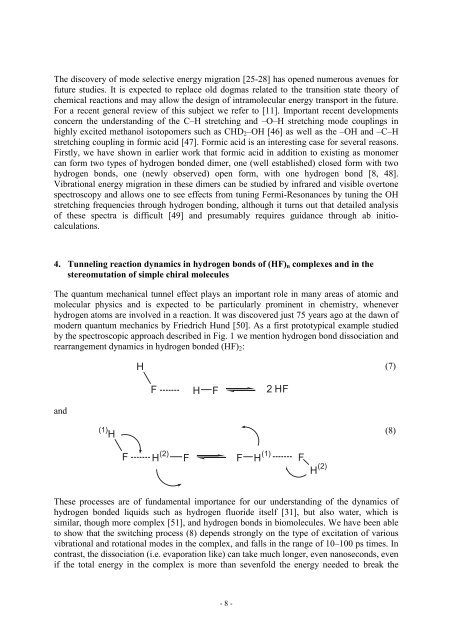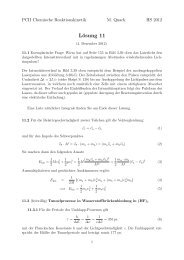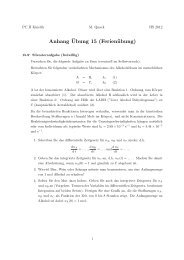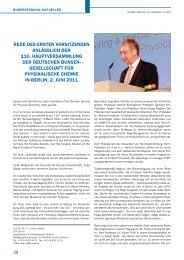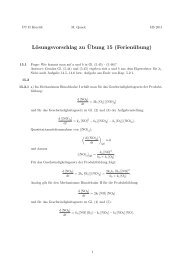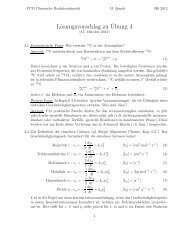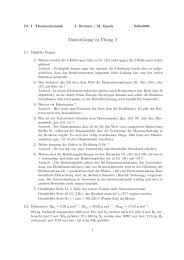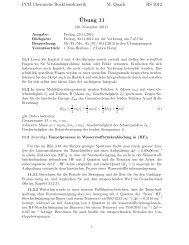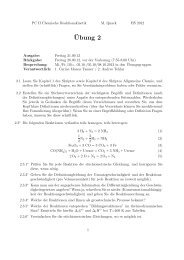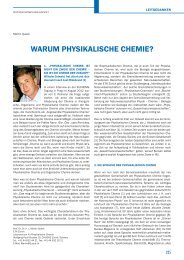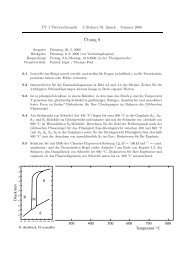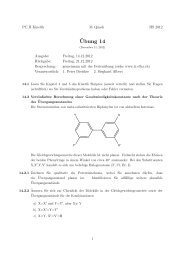Molecules in Motion - Quack - ETH Zürich
Molecules in Motion - Quack - ETH Zürich
Molecules in Motion - Quack - ETH Zürich
You also want an ePaper? Increase the reach of your titles
YUMPU automatically turns print PDFs into web optimized ePapers that Google loves.
The discovery of mode selective energy migration [25-28] has opened numerous avenues for<br />
future studies. It is expected to replace old dogmas related to the transition state theory of<br />
chemical reactions and may allow the design of <strong>in</strong>tramolecular energy transport <strong>in</strong> the future.<br />
For a recent general review of this subject we refer to [11]. Important recent developments<br />
concern the understand<strong>in</strong>g of the C–H stretch<strong>in</strong>g and –O–H stretch<strong>in</strong>g mode coupl<strong>in</strong>gs <strong>in</strong><br />
highly excited methanol isotopomers such as CHD 2 –OH [46] as well as the –OH and –C–H<br />
stretch<strong>in</strong>g coupl<strong>in</strong>g <strong>in</strong> formic acid [47]. Formic acid is an <strong>in</strong>terest<strong>in</strong>g case for several reasons.<br />
Firstly, we have shown <strong>in</strong> earlier work that formic acid <strong>in</strong> addition to exist<strong>in</strong>g as monomer<br />
can form two types of hydrogen bonded dimer, one (well established) closed form with two<br />
hydrogen bonds, one (newly observed) open form, with one hydrogen bond [8, 48].<br />
Vibrational energy migration <strong>in</strong> these dimers can be studied by <strong>in</strong>frared and visible overtone<br />
spectroscopy and allows one to see effects from tun<strong>in</strong>g Fermi-Resonances by tun<strong>in</strong>g the OH<br />
stretch<strong>in</strong>g frequencies through hydrogen bond<strong>in</strong>g, although it turns out that detailed analysis<br />
of these spectra is difficult [49] and presumably requires guidance through ab <strong>in</strong>itiocalculations.<br />
4. Tunnel<strong>in</strong>g reaction dynamics <strong>in</strong> hydrogen bonds of (HF) n complexes and <strong>in</strong> the<br />
stereomutation of simple chiral molecules<br />
The quantum mechanical tunnel effect plays an important role <strong>in</strong> many areas of atomic and<br />
molecular physics and is expected to be particularly prom<strong>in</strong>ent <strong>in</strong> chemistry, whenever<br />
hydrogen atoms are <strong>in</strong>volved <strong>in</strong> a reaction. It was discovered just 75 years ago at the dawn of<br />
modern quantum mechanics by Friedrich Hund [50]. As a first prototypical example studied<br />
by the spectroscopic approach described <strong>in</strong> Fig. 1 we mention hydrogen bond dissociation and<br />
rearrangement dynamics <strong>in</strong> hydrogen bonded (HF) 2 :<br />
0<br />
(7)<br />
. 0 . 0 .<br />
and<br />
0<br />
. 0<br />
(8)<br />
<br />
. . 0<br />
<br />
.<br />
0<br />
<br />
These processes are of fundamental importance for our understand<strong>in</strong>g of the dynamics of<br />
hydrogen bonded liquids such as hydrogen fluoride itself [31], but also water, which is<br />
similar, though more complex [51], and hydrogen bonds <strong>in</strong> biomolecules. We have been able<br />
to show that the switch<strong>in</strong>g process (8) depends strongly on the type of excitation of various<br />
vibrational and rotational modes <strong>in</strong> the complex, and falls <strong>in</strong> the range of 10–100 ps times. In<br />
contrast, the dissociation (i.e. evaporation like) can take much longer, even nanoseconds, even<br />
if the total energy <strong>in</strong> the complex is more than sevenfold the energy needed to break the<br />
- 8 -


